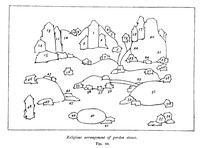The second historical style belongs to the Kamakura Period,�that is from the middle of the twelfth to the beginning of the fourteenth century, during which time Kamakura was the seat of the Regency. The art of gardening, together with architecture and other attendant arts, seems then to have received a great impulse at the hands of the Bulddhist priests. Considerable attention was bestowed on the selection and grouping of standing-stones, which were given imaginary religious and moral attributes, and disposed so as to represent the members of the Buddhist pantheon (see Fig. 10). As will be afterwards explained, many of these fancies still survive even in connection with buildings having no religious purpose. In the larger gardens of this period a lake was deemed an essential feature. Many names remain recorded for islets placed in lakes and rivers. Such are:�"Hill Island," "Wooded Island," "Rocky Island," "Wild-moor Island," "Cloud-shaped Island," "Misty Island," "Drybeach Island," and "Pine-bark Island." A variety of cascades are also mentioned such as:�"Front Fall," "Side Fall," "Stepped Fall," "Spouting Fall," "Thread Fall," "Woolly Fall," "Right-and-left Fall," and "Folding Fall," these terms alluding to the character of the torrent displayed. The direction of the flow of garden streams was, as fixed by rule, from East to West, the opposite arrangement being pronounced left-handed and unlucky. References are made to the technical methods followed in arranging ornamental sheets of water. First, the general outline of the lake and islands were designed and excavated, due attention being paid to the nature of the site. A few of the most important rocks were then placed in position, and finally, the stream or water-fall forming the inlet, and also the outlet of the lake, were carefully arranged.

